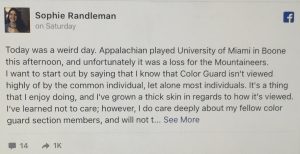By MARISSA VONESH
Since Donald Trump became the president-elect on Nov. 8, citizens across the United States have protested the president-elect himself along with other concerns.
Protests – mainly generated in urban areas – have grown to be more than just a defiance of Trump and his actions. Now, protestors, dominantly young adults, are peacefully taking the streets to advocate for minority rights and overall discontent with American politics.
However, many protesters did not even participate in this year’s election. For example, in Oregon about two-thirds of the arrested protesters either chose not to vote or were and are not registered to vote.
The dissatisfaction with Trump has cultivated a platform for the American public to walk together and discuss discontent. Aside from political protests, now protests against the Dakota Oil pipeline are popping up across the country.
News media outlets have covered the nationwide protests and other impacts of the election, such as the increased hate crimes towards minorities and violence towards Trump supporters.
The news organizations are taking their traditional biases. Fox News continues to speculate on whether the protests are real or paid propaganda and discusses the millennial dissatisfaction with a mocking tone. On the other hand, many outlets besides Fox have failed to report maltreatment of Trump supporters and have leaned heavily left following the election.
Where all organizations are failing is the in represention of the people who voted for Trump. Where are the people who voted for Trump? What are their lives like? Are they all rural, uneducated, white males?
Social media is overwhelmed with posts claiming, “Maybe not all Trump supporters are racists, sexist, etc., but they all decided that they weren’t deal breakers.” With comments like these, the protests and the general effects of the election, it appears like those who voted for Trump have no voice. Dialogue is not happening between the opposing views, yet it is necessary for both sides to state their opinions in order for the country to prosper.
Although racism, sexism and hatred in general should never be tolerated, there is an entire segment of the United States population that has been put into a box and dismissed.
In a few instances, media is speculating about these voters. For example, in a post on Glenn Beck’s website by Riaz Patel, executive producer of Axial Entertainment, Patel shares his experience as a gay, Muslim, Pakistani-American immigrant trying to understand Trump voters in Alaska.
This reflection sheds more light on the Trump voters than most news organizations have presented. Patel explains their economic struggles and their hope for a change. Patel suggests that a selection of the population was voting for social issues, whereas another was voting for “survival.”
By exploring the Trump voters’ perspectives in black and white perspectives, the American media is, in many ways, continuing to point fingers and divide the nation. When most of the American public sit in an area of gray, it is extremely important that journalists investigate and report fairly to make a more informed society. Hate from all sides is only exacerbated by the media, and although news does not create the hate, it does have the power to quell it in many instances.
Information is key. Unbiased reporting is key. Thorough investigation is key. When the news outlets are failing to put these type stories on the front page or on their Facebooks, more divide, and sadly mistrust, is cultivated.

